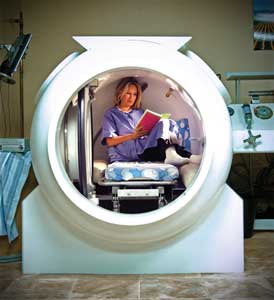|
|
|||
| Hyperbaric Oxygen Therapy
|
|
||
|
FREE! Natural Weight Loss
Program recommended by The Share Guide
|
Necessary for life,
oxygen is the basic building block for healing, which makes oxygen
therapy essential and logical for patients whose healing is
compromised. Hyperbaric Oxygen Therapy (HBOT) is quickly becoming the
preferred adjunct therapy for patients with non-healing wounds,
radiation damage, chronic illnesses, and many more conditions. HBOT
increases the oxygen gradient in damaged, oxygen starved tissues. The
oxygen you breathe in the chamber dissolves into your blood more
efficiently, acting as a cellular energy catapult so that your plasma
and tissues are saturated beyond a cellular level. A cascade of healing
mechanisms are then triggered which include an increase of collagen
production, an improvement in auto-immune response, a reduction in
inflammation and swelling, and inhibition of bacteria. HBOT therapy has been used successfully in the treatment of stroke, diabetes, ischemia, and anemia. A treatment course of HBOT, when followed correctly, promotes the growth of red blood vessels, or Angiogenesis. Without such growth, proper circulation and complete healing couldn't take place, since no medications or drugs can produce those benefits. Basic gas laws explain how oxygen under slight pressure not only diffuses into cells easily, it can do so with up to 14 to 20 times the normal amount of oxygen that we breathe at sea level. HBOT thus provides an exponential amount of oxygen to hypoxic, or oxygen starved tissue. Stroke Stroke accounts for 10% of deaths in all industrialized countries. It is the most common cause of disability worldwide. Some important factors in a stroke patient's recovery are the extent of two separate things: the infarct and the penumbra. The penumbra lies between the zones of infarction and normal brain, containing the so-called dormant or idling neurons. These neurons are nonfunctional but anatomically intact and can be revived. The presence of viable brain tissue in the penumbra explains why the acute clinical presentation of a stroke is a rather poor predictor of the outcome. Key attributes of HBOT are that it decreases cerebral edema and can reawaken the stunned neurons within the penumbra by providing them with oxygen. Activation of these neurons explains why patients can show improvement when HBOT is administered years after stroke occurs. Other HBOT benefits include: relief of oxygen starvation, improvement of microcirculation, relief of brain swelling, and reduction or relief of spasticity. Diabetes Diabetes affects millions of Americans. Serious long-term complications include cardiovascular disease (doubled risk), chronic renal failure, retinal damage, and nerve and microvascular damage, which may cause poor healing. Poor healing of wounds, particularly of the feet, can lead to gangrene which can require amputation-the leading cause of non-traumatic amputation in adults in the developed world.Oxygen's fundamental role in healing can provide a reversal of diabetic neuropathy, providing necessary oxygen to tissue at a wound site, allowing for improved circulation and healing. Trauma Acute traumatic ischemia occurs when an injury interrupts blood flow to an extremity. Examples are open fractures that tear major arteries, or crush injuries and skeletal muscle compartment syndromes which starve the microcirculation. This can lead to infection, non-healing wounds, non-healing fractures, and necrosis, which can require amputation. Problems are compounded in compromised patients such as those with diabetes, malnutrition, advanced peripheral vascular disease, or collagen vascular diseases. HBOT at 2 ATA increases blood oxygen content by 25%, but increases plasma and tissue oxygen tension 10-fold. The net effect is a threefold increase in oxygen diffusion through tissue fluids. Increased oxygen reduces edema through vasoconstriction, which further promotes oxygenation. Increased oxygen tensions in hypoxic tissues allow healing and helps prevent spread of infection and damage to adjacent, non-involved tissue, decreasing complication rates and cost of management. Hyperbaric Oxygen Therapy speeds demarcation of non-viable tissue, and reduces reperfusion injury by preventing lipid peroxidation, neutrophil adherence, and free radical buildup. Anemia Exceptional blood loss anemia occurs when so many red blood cells are lost that oxygen delivery to tissues is compromised. Some patients cannot be treated by transfusion to restore red blood cell mass for various reasons. Medical reasons include inability to cross match blood, and some may refuse transfusions for fear of a communicable disease. In 1956 Dr. Ite Boerma removed the red blood cells from pigs and found they could survive with oxygen dissolved in the plasma by use of hyperbaric oxygen. Hyperbaric oxygen can temporarily support life without hemoglobin. The increased oxygen carrying capacity of blood during Hyperbaric Oxygen Therapy is enough to support basal metabolic needs at rest. The advantages of Hyperbaric Oxygen Therapy as an adjunct to cardiac surgery can be summarized as follows: it increases the safe time of induced cardiac arrest under normal body temperature; it reduces the impact of hypoxic complications and metabolic disturbances associated with cardiac surgery; it enables surgery to be performed without blood transfusion in some cases. HBOT is the treatment of choice for air embolism as a complication of cardiac surgery. Despite HBOT's multiple benefits, cost effectiveness, and growing number of positive clinical trials, many patients are still not being referred to hyperbaric centers because only a fraction of doctors are educated about this therapy. Hyperbaric Recovery Center is an award-winning treatment facility in Larkspur, CA. They offer hospital standards of Hyperbaric treament in a spa-like setting, at an affordable rate. They are preferred providers for some prominent insurance companies, which can help many patients get HBOT treatment with a doctor's prescription for treating one of the 14 approved diagnoses for HBOT. To learn more or schedule a complimentary tour of the Center, call 415-785-8652, visit their website at www.improvehealing.com Related Info: Hyperbaric Oxygen Therapy Real Preventive Medicine Herbs For Cancer Prevention Complementary Health Care Acupuncture for Headaches Real Preventive Medicine Natural Weight Loss Program recommended by The Share Guide: learn more MORE
HEALTH ARTICLES  Follow us on Facebook Follow us on FacebookHome Shop |
||
|
|
|||
|
|
|
||

